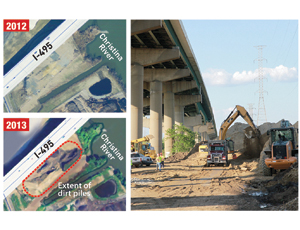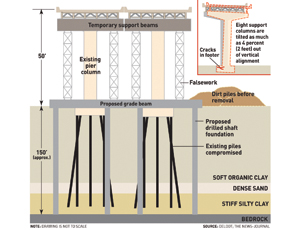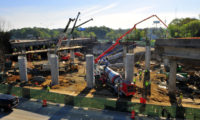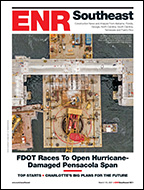

The Delaware Dept. of Transportation and its consulting engineers are rushing to build new foundations for a section of the I-495 bridge through Wilmington. On June 2, DelDOT closed the span, a key six-lane north-south throughway that carries an estimated 90,000 cars per day, after learning that four of 37 piers were out of vertical alignment by up to 4%. Current estimates place the temporary repair project at $20 million. DelDOT said on June 10 it hopes to have the link partially back in service by Labor Day.
A large pile of dirt stored adjacent to the bridge by Keogh Contracting, a local firm, may have been a contributing factor to the structure's shift, which made DelDOT's first priority to remove the dirt, according to Barry Benton, assistant director of bridges. The estimated 50,000 tons of dirt, at 300 ft long, 150 ft wide and 20 ft to 30 ft high, could have been compressing the soft soil—consisting mostly of organic sediment—upon which the bridge is built. DelDOT put the contractor's removal cost at $260,000. Keogh did not return calls for comment.
After removing most of the soil, DelDOT detected slight, 0.1° rebounding in the affected piers, giving state officials more confidence the mound of soil was the primary cause of the tilt.
Moving forward, DelDOT will replace the steel piles supporting the eight piers with a concrete foundation: eight subsurface pillars per pier, unified by a grade beam. To support the super- structure, crews will erect falsework supported by 24 100-ton jacks.
Piers 12 and 13 also will be replaced entirely, while piers 11 and 14 can be underpinned to the new foundation.
"Everything in the ground is no longer viable for a long-term solution," Delaware Transportation Secretary Shailen Bhatt said. He also cited difficulty in building underneath an existing structure and finding equipment to operate in the limited space.
An excavation of the affected pile caps on June 5 revealed horizontal cracks through all the caps, which is "a pretty strong indication that lateral displacement happened," according to Robert McCleary, chief engineer of DelDOT.
Bhatt also acknowledged the possibility that the entire bridge section might have to be replaced, depending on what is found once drilling begins.
After inspecting the four spans, DelDOT did not find the components to be overstressed, at least without a live load, according to Benton.
The excavation also allowed DelDOT to rule out corrosion as a contributing factor. The agency believes damage is isolated to the four leaning piers.



Post a comment to this article
Report Abusive Comment